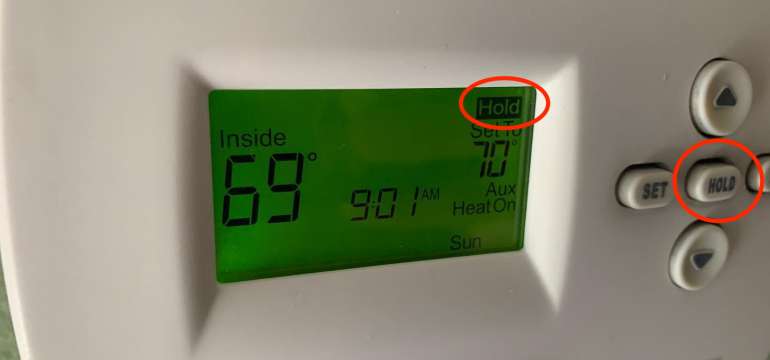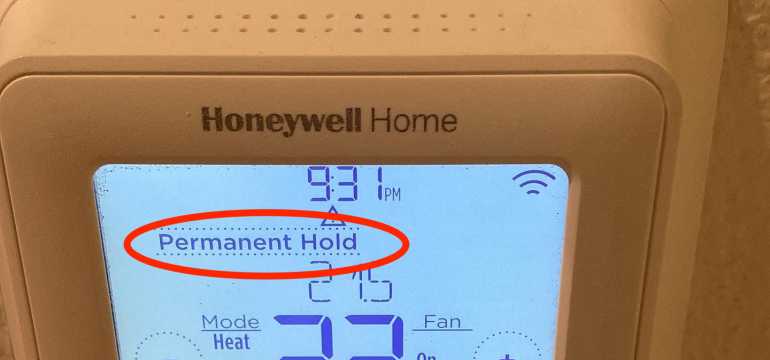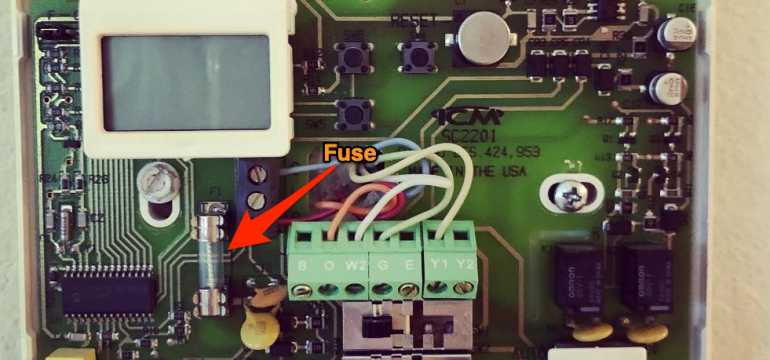If your thermostat keeps resetting, first see whether you have a programmable or non-programmable model. If it’s not programmable, the problem could be either with the batteries or the internal circuit board. If it is programmable, it could be on the “Hold” setting, or you might be in a demand response event.
But those are just a few reasons why your thermostat could keep resetting. Keep reading to get a closer look at the most common causes and solutions for this problem.
My programmable thermostat is resetting
Many people today have programable thermostats. If you have one as well, then the first step to figuring out why it’s resetting is seeing if it’s on “Hold.” If you hold down the “Hold” button, the programmed schedule will be cleared.
What does hold mean on a thermostat?

A thermostat’s hold setting is kind of like an override button. It lets you set the thermostat to a temperature that’s not on your normal schedule.
For example, let’s say you programmed your thermostat to be at 70 degrees at noon. When the hold button is on, you could override that programming to place the thermostat at 72 degrees one day at noon.

There are usually two different hold options. The first is called “Permanent Hold.” This essentially leaves your override running until you manually cancel it.
The second option is called “Temporary Hold” or “Hold Until.” This option lets you override the thermostat’s programming until a certain point in time. It’s a good option if you know exactly when you want the normal programming to return.
Getting your thermostat off the hold setting
Getting your thermostat off of hold is pretty easy. You will need to just press one of the following buttons on your device:
- Cancel
- Run
- Run Schedule
The specific button that you press will depend on your model. Once you press this button, the thermostat should get back to its normal schedule.
What happens during a demand response event?
It’s also possible that your problem is stemming from a demand response event. These tend to occur in summer when temperatures are at their hottest.
When the weather is extremely hot, everyone uses their air conditioners at full blast. That creates an immense demand on the electrical grid.
To save the grid from blacking out, the utility company may ask people to turn up their thermostats. This reduces the demand on the grid and saves it from going out entirely during times of high energy consumption.
This could happen automatically if you have a smart thermostat and are enrolled in a local energy-saving program. When those two conditions are met, the utility company may be able to automatically adjust your thermostat remotely.
If this is your problem, then don’t worry. It should go away automatically once the demand for electricity goes down in your area. You may also be able to opt out of this by unenrolling from an energy-saving program.
My non-programmable thermostat is resetting

Though non-programmable thermostats are a bit rarer nowadays, they can still have resetting issues. These are typically caused by problems with the battery.
Sometimes, the batteries for these units can leak acid, which can cause the thermostat to malfunction. Solving the problem may be as simple as replacing the batteries.
If changing batteries doesn’t work, it might have a circuit board issue. In this case, it’s best just to get a new thermostat.
Your thermostat could be restarting
Though the problems and solutions covered above are some of the most common, they aren’t the only ones to think of. There are lots of reasons why your thermostat could keep restarting as well.
We’ll cover those reasons and give you some solutions to them in this section.
A blown fuse could be the problem

It’s also possible that you’re having an issue with a blown fuse. Fuses are present in every electronic device. It’s their job to protect the device from getting too much voltage and shorting a circuit.
But sometimes fuses burn out. And when that happens, it can cause your HVAC system to act abnormally. It may lead to your thermostat resetting.
The good news is that this problem is pretty easy to spot. Usually, your thermostat will tell you that a fuse has blown. It does this by showing screen icons, and yours might even have an audio beeping signal.
You may be able to swap out the blown fuse yourself. But working with wiring can be dangerous if you don’t know what you’re doing. So calling a professional out to take a look at your thermostat could be your best option.
You could have faulty wiring
It’s also possible that the wiring in your home is what’s causing your thermostat problem.
The electrical wiring in your home is a complicated system. Getting a short circuit or having a loose connection in one room could cause your thermostat to malfunction in another.
That’s why it’s a good idea to check for loose and faulty wiring in your home on a consistent schedule. Doing so will allow you to rule out this problem in the future.
But if you haven’t checked your wiring recently, now may be the time to do so. An electrician may find a problem that’s been causing your thermostat to reset.
There might be a defect in the thermostat
Thermostats are usually pretty reliable. But they don’t always work the way that they should. In fact, your thermostat may have been manufactured with a defect.
Though rare, it’s possible that you just got unlucky if you’re having thermostat resetting issues. But you would find this out pretty quickly after installing the thermostat. A manufacturing defect shouldn’t take months or years to reveal itself.
Typically, a company will replace your thermostat with a new one if it has a defect. You may just need a professional to come out and verify that you have one.
The screen backlit LED could be the problem
Modern thermostats have screens that are backlit by LEDs. These can sometimes malfunction.
When your LED malfunctions, it will likely cause the screen to go blank. That would make it look like the thermostat is turned off even when it might not be.
When that happens, you might try pressing a bunch of buttons at random to turn the thermostat back on. And something you pressed might be causing your thermostat to deviate from its programmed schedule.
If you can control your HVAC system with a mobile app, try doing that. You may see what’s causing your problem and be able to fix it.
Or maybe you don’t have mobile control over your HVAC system. In that case, calling out a professional to resolve the LED issue may be your best option.
Your screen might not be responding in general
It’s also possible that your screen just isn’t responding in general. That is, it’s frozen, and you can’t press any buttons at all.
Many screens will have a built-in feature to resolve this problem automatically. They’ll typically restart themselves and refresh the system after cycling through a few tries.
But your thermostat may or may not do this. If it doesn’t, then you might need to call out a professional to help you out. They can probably restart the thermostat manually to fix the issue.
You might even be able to do this yourself. You can look at your owner’s manual to see if there’s a way to manually reset your system.
Auto-updating could be a problem
Some thermostats are also set up to update automatically. This requires an internet connection.
But if your thermostat updates automatically, it will probably reset a few times while doing so. So the problem that you are noticing could just be a sign that your system is updating itself.
You might need to swap out your battery
Weak batteries can also be a problem that causes restarting on programmable thermostats.
If batteries don’t have enough power, they may cause the thermostat to turn off and on at random. This can create a situation in which your programmed settings don’t always go through.
Make sure to solve this problem quickly if you’re experiencing it. Running your thermostat with a weak battery can affect your HVAC system seriously.
Short cycling
If your thermostat is restarting on its own, it could be a sign of short cycling. The reasons might be more related to your HVAC system. You can read the related article here.
Does your HVAC system work properly if the thermostat batteries are dead?
If the thermostat is powered by batteries, the answer is no. Your HVAC system won’t work correctly.
That’s because batteries power the relays. It sends a low voltage signal into the HVAC unit’s circuit board. And that’s how the relays engage the desired services.
If a thermostat’s battery is dead, it won’t be able to power the relays.
- What to Do if Your House Smells Like Gas but There’s No Leak - February 6, 2023
- Why Is There a Burning Smell Coming From My Vents? - August 16, 2022
- How to Remove the Musty Smell From Your Air Conditioner - August 16, 2022
